Latin Mass: History & FAQ's
It goes by many names—Traditional Latin Mass (TLM), Extraordinary Form (EF), Usus Antiquior ("Ancient Use"), 1962 Missal, Missal of St. Gregory the Great, Mass of the Ages, Tridentine Mass, Classical Mass. It has formed the Church's saints for two millennia and has been passed down faithfully through the ages with no substantial changes. The NWI Latin Mass Community works to preserve it in northwest Indiana for future generations.
Development & Preservation
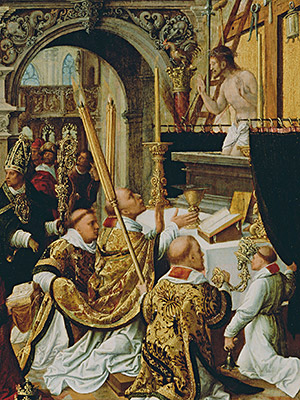
After Pentecost, the apostles spread throughout the world. The bishops of the metropolises of Rome (the pope), Antioch, Alexandria, Jerusalem, and Constantinople each maintained their own forms of liturgy. Though originally Greek, the language of the Roman church changed to Latin around the second century. For Roman Catholics, the Traditional Latin Mass descends from this period. Bl. John Henry Cardinal Newman remarks, the Traditional Latin Mass is "virtually unchanged since the third century."1
In the sixth century, Pope St. Gregory the Great codified the Mass, especially "Gregorian" chant, which takes its name from him. In the eighth century, the Roman Emperor Charlemagne helped to better standardize prayer books for use across the Empire.
During the Protestant Revolt, abuses crept into the Mass in many places. In an effort to restore the Mass, Pope St. Pius V wrote "Quo Primum" in 1570 and declared, "We grant and concede in perpetuity that . . . this Missal is hereafter to be followed absolutely . . . and may freely and lawfully be used." Since his restoration occurred shortly after the Council of Trent, the Traditional Latin Mass is sometimes referred to as the "Tridentine Mass" or the "Missal of St. Pius V."
Second Vatican Council
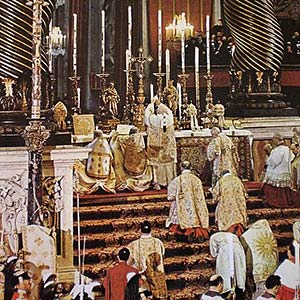
The Traditional Latin Mass is the only form of Mass that was celebrated at Vatican Council II.
The Council Fathers approved the constitution "Sacrosanctum Concilium" concerning the Sacred Liturgy. It doesn't call for any major reforms. Instead, it requires that Gregorian chant maintain "pride of place" and that "use of the Latin language is to be preserved." It makes no mention of removing beautiful high altars, Communion rails, or stained glass windows; it didn't call for beautiful paintings to be painted over or statues to be removed; nor does it call for re-orienting the priest to face the people rather than a common direction toward our Lord. It made no changes to the ancient practice of receiving Holy Communion on the tongue while kneeling from a priest. While Vatican II didn't call for these innovations that would follow it, it would often be cited for them.
The loss of these traditions in most places almost led to the complete loss of the Traditional Mass during the tumultuous 1970's.
God Works through the Saints
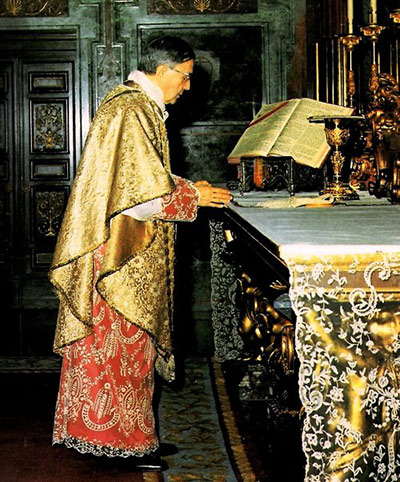
Three of the most popular saints of the 20th century kept the Traditional Latin Mass alive. At first, the Vatican issued a limited number of "indults," allowing particular priests and places to offer the TLM. St. Padre Pio and St. Josemaria Escriva2 were among the very first to obtain these indults.
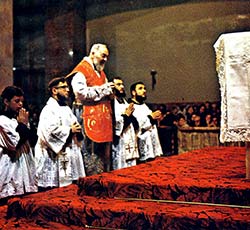
Intellectuals, scholars, artists, and authors from across Europe petitioned the Vatican to make the Traditional Mass more available in England. The Vatican granted their request in what is sometimes called the "Agatha Christie Indult," after the famous mystery writer and signatory to the petition.
In 1984, Pope St. John Paul II issued "Quattuor Abhinc Annos," asking bishops throughout the world to generously permit celebrations of the Traditional Latin Mass to groups requesting it. He followed it in 1988 with "Ecclesia Dei Adflicta," which called on bishops to be even more generous in offering the TLM. This legislation sought to heal the wounds caused by the liturgical changes but unfortunately weren't respected in every diocese.
Pope Benedict XVI "Frees" the Latin Mass
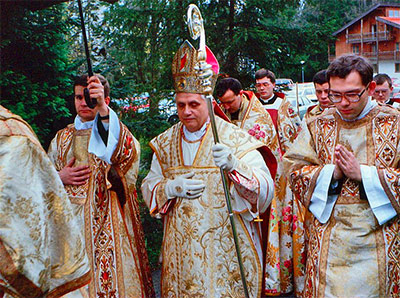
With the growth of the Traditional Latin Mass throughout the world over the following quarter century, especially among young people, Pope Benedict XVI issued the landmark legislation "Summorum Pontificum" in 2007 with an accompanying explanatory letter to bishops, completely "freeing" the Ancient Liturgy and clarifying that the new form of Mass didn't in any way abrogate the ancient form.
This legislation clarified that every Roman Catholic priest may celebrate the Traditional Latin Mass without seeking permission from his bishop; furthermore, it required pastors to allow for its celebration whenever a group of people requests it. If a pastor is unable to fulfill their wishes, it required the bishop to provide a suitable solution, and if the bishop could not, a special Vatican commission named "Ecclesia Dei" would become involved. The document "Universae Ecclesiae" was issued afterwards to clarify, enforce, and protect various points of this momentous legislation.
Frequently Asked Questions
-
Why are so many young people attracted to the Traditional Latin Mass?
-
The traditions of the Church instinctively attract all people. Youth especially seek a form of liturgy that has depth, mystery, and meaning. In a modern world so confused and devoid of meaning, the richness of Catholic culture and tradition is inspiring. Pope Benedict XVI wrote in a letter to bishops of the world:
Immediately after the Second Vatican Council it was presumed that requests for the use of the 1962 Missal would be limited to the older generation which had grown up with it, but in the meantime it has clearly been demonstrated that young persons too have discovered this liturgical form, felt its attraction and found in it a form of encounter with the Mystery of the Most Holy Eucharist, particularly suited to them.
-
Why does the priest face the altar and not the people in the Traditional Mass?
-
The focus of Mass is our Lord, not the priest or his personality. In every Divine Liturgy since the beginning of the Church until the modern age, the priest and people always faced a common direction of prayer, known as "liturgical East." As a cardinal, Pope Benedict XVI explained why:3
The common turning toward the East was not a "celebration toward the wall"; it did not mean that the priest "had his back to the people": the priest himself was not regarded as so important. For just as the congregation in the synagogue looked together toward Jerusalem, so in the Christian Liturgy the congregation looked together "toward the Lord."
At the Last Supper, Christ and his apostles faced the same direction in prayer.4 This continues in the Traditional Latin Mass.
-
How does one follow the Mass if it's in Latin?
-
The best way to experience the Latin Mass is to "pray the Holy Mass," as Pope St. Pius X exhorted us. The Latin Mass naturally encourages the active participation of the laity—listening to any priest recite prayers is only a passive participation.
Most places (and all locations in northwest Indiana) offer the ubiquitous "red missals" or something similar at the back of church for the faithful to borrow. These little missals have the Latin prayers on one side and their (very beautiful) English translations on the other. They are very helpful for beginners. It's best to read the prayers as the priest does. Just remember that it takes time to get accustomed to the Traditional Mass because it's so rich and meaningful—don't be intimidated if you lose your place!
The red missals don't contain the several changing, or "proper," prayers of Mass, such as the Epistle and Gospel. So you'll eventually want to graduate to a full "hand missal." The most popular is the Roman Catholic Daily Missal; many others are available, including the Baronius Daily Missal, and the Saint Andrew Daily Missal to name a few. It is a worthy investment that will last a lifetime. Your parents or grandparents may even still have theirs!
-
How can I learn more about the meaning of the ceremonies in the Latin Mass?
-
An old but excellent online video narrated by the Venerable Fulton J. Sheen explains the ceremonies of the Traditional Latin Mass and their rich symbolism (the Mass takes place at a church in Chicago). Sancta Missa offers free online training videos and documentation for priests and servers. A classic and thorough book is The Holy Sacrifice of the Mass by Nicholas Gihr, which is available in print and for free online.
-
I'm completely new to the Latin Mass. What can I expect at my first visit?
-
Grab a Latin-English missalette from the back to help follow the Mass, but don't be discouraged if it's difficult to follow on your first visit. Enter the church and take your pew as usual. The postures—kneeling, standing, and sitting—are a little different, but just follow everyone else. The biggest difference is that, shortly after the Traditional Mass begins, everyone kneels while the priest prepares to ascend the altar.
If a collection is taken up, it is done at the Offertory as usual.
Lines are formed as normal for Holy Communion, but receiving is different. Communicants kneel (or stand if they have difficulty) along the Communion rail. There they wait as the priest goes back and forth across the sanctuary distributing. When you get to the front of the Communion line, wait for a nearby spot at the Communion rail to become available and then kneel down there. Wait there until the priest comes to you, and he will give you Communion on the tongue (not the hand). Communicants don't say "Amen" when receiving. Then return to your pew as usual.
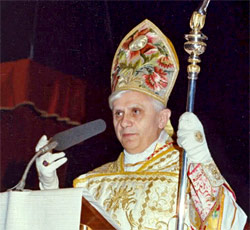
at a Traditional Latin Mass
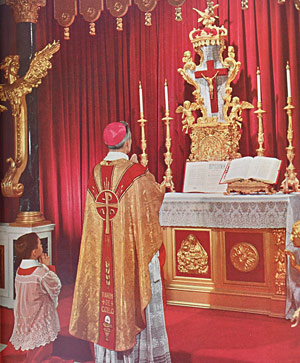
(as his nephew serves)
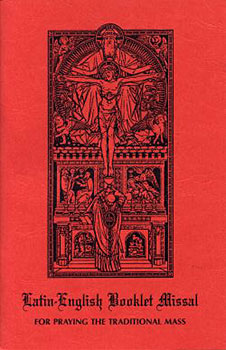
References
- Newman, J. H. Callista. 1901.
- Kwasniewski, P. "Reclaiming St. Josemaria Escriva for the New Liturgical Movement." Sept. 19, 2016.
- Ratzinger, Joseph. Spirit of the Liturgy. Ignatius Press, 2000.
- Gamber, Klaus. The Reform of the Roman Liturgy: Its Problems and Background. Una Voce Press, 1993. (Then-Cardinal Joseph Ratzinger wrote the preface to this book.)